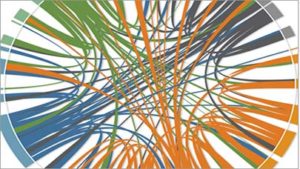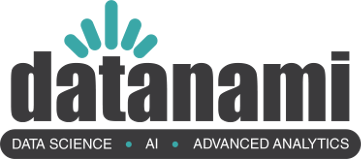

When the CTO for marketing analytics firm Qualia set out to build a new system consumer behavior tracking system, he knew the database selection would be critical. Little did he know that Qualia would end up pushing the limits of the graph database chosen to power the new system.
Qualia is a New York City ad-tech firm that works with advertising agencies and major brands to help identify “intent signals” captured across people’s smart phones, tablets, and PCs. The company collects data on more than 90% of American households, and uses that data to essentially give clients a heads-up when a consumers is likely to be is receptive to a pitch.
Timeliness and accuracy are key to what Qualia does. For example, if a consumer loaded a webpage about cars, that would be considered a “low quality” signal, and that engagement would go into a bucket with 300 million other “auto intenders,” explains Qualia CTO Niels Meersschaert. “It’s not really that meaningful,” he says. “Otherwise we’d sell 300 million cars.”
However, if that search occurs on a smart phone while the consumer is standing in a Ford dealership, that search suddenly has greater meaning. Qualia’s goal is to sift through all that real-time signal information, sort out the low quality signals from the higher quality ones, and decide which consumers are
As Meersschaert explains, it’s critical to differentiate who’s holding which device, where, and when. “By knowing the specific device that that signal occurred on, and knowing that multiple devices are associated with the same consumer or household in a sense, we are able to build a smarter model about what the actual intent is of that consumer at any moment in time,” he says.
The company relies on a steady stream of data collected via cookies and other tracking mechanism used on the Web. The data is largely proprietary, and anonymized to prevent it from being abused. Managing the incoming data stream is one issue that Qualia has to deal with, but doing something useful with the data is much more important.
Qualia’s data naturally forms a tree-like structure, with parent-child relationships. Each household contains one or more people, and each of those people use one or more computer devices, each of which is tracked with its own identification number.
Describing that sort of data structure in a relational database would be possible, Meersschaert says, but it would be far from ideal.
“You’d end up making all these duplicate data entries, and your data would become far larger than it needs to be,” he tells Datanami. “To get access to any piece of data, you’d either have to have a very wide table, which will be very expensive to update and change, or you’re going to have to have a massive number of joins, which is very slow from an operational perspective.”
Meersschaert realized very early on that a graph database would be the right approach. He considered various open source graph databases, including one called Titan. While Titan had its plusses, the CTO found its traits lacking for Qualia’s specific use case.

Neils Meersschaert is CTO at Neo4j user Qualia
“The problem we found with doing something with Titan with an HBase back is the way HBase works,” he says. “There’s a single key that’s on each table, and so every single element that you might query against would be a new table. So you basically had to know all the indexes before you created the tables.”
That would have limited Titan’s usefulness, he says. “It didn’t give you the ability to change [the index] after the fact. It ended up having a tremendous amount of duplication of data when you do a columnar store, because you don’t have the concept of oh here’s a node, and all the things that describe that node are held together.”
Qualia eventually settled on Neo4j, a property graph database developed by Neo Technology. Meersschaert says the way data is stored in nodes and edges in Neo4j is a very good match to the tree-like structure of Qualia’s customer intent data.
Today Qualia’s graph database contains 3 billion nodes and 9 billion edges. This data encompasses 1.2TB of data sitting across three nodes in a cluster of X86 servers. The data is sharded manually, since Neo Technology doesn’t support automatic sharding yet.
“We’re actually one of the largest installations of a graph database globally, which is kind of eye opening to use because we were just making this stuff work,” Meersschaert says.
It’s true that some databases are much larger than 1.2TB. But when you consider how storing the equivalent data in a relational structure would balloon the amount of data by a factor of 10, and slow queries down to a crawl, then you realize how a graph database is such a good fit for this particular use case, he says.
“A graph database allows you to be far more efficient in terms of traversing from one point to another,” Meersschaert says. A relational database could do the work at the end of the day, but “it doesn’t allow you to traverse from one point to another point along a path. This is where a graph-based database makes sense.”
It’s all about using the right tool for the job, Meersschaert says, adding that MongoDB, Hadoop, BigQuery, and Spark all play a role at Qualia. “We use the technology that’s appropriate to the task at hand,” he says.
These other systems work with Neo to surface the right data in the right format, according to a case study posted to the Neo website. Qualia relies on a Ruby-developed app called Spirograph to communicate with Neo4j by either inserting data into or pulling data from the graph in Ruby, which is then processed in Hadoop, Spark and BigQuery. The company also relies on Cerebro to convert user coordinates into a commercial location, which is stored in MongoDB.
Related Items:
JanusGraph Picks Up Where TitanDB Left Off
Neo4j Touts 10x Performance Boost of Graphs on IBM Power FPGAs
Graph Databases Everywhere by 2020, Says Neo4j Chief
April 26, 2024
- Google Announces $75M AI Opportunity Fund and New Course to Skill One Million Americans
- Elastic Reports 8x Speed and 32x Efficiency Gains for Elasticsearch and Lucene Vector Database
- Gartner Identifies the Top Trends in Data and Analytics for 2024
- Satori and Collibra Accelerate AI Readiness Through Unified Data Management
- Argonne’s New AI Application Reduces Data Processing Time by 100x in X-ray Studies
April 25, 2024
- Salesforce Unveils Zero Copy Partner Network, Offering New Open Data Lake Access via Apache Iceberg
- Dataiku Enables Generative AI-Powered Chat Across the Enterprise
- IBM Transforms the Storage Ownership Experience with IBM Storage Assurance
- Cleanlab Launches New Solution to Detect AI Hallucinations in Language Models
- University of Maryland’s Smith School Launches New Center for AI in Business
- SAS Advances Public Health Research with New Analytics Tools on NIH Researcher Workbench
- NVIDIA to Acquire GPU Orchestration Software Provider Run:ai
April 24, 2024
- AtScale Introduces Developer Community Edition for Semantic Modeling
- Domopalooza 2024 Sets a High Bar for AI in Business Intelligence and Analytics
- BigID Highlights Crucial Security Measures for Generative AI in Latest Industry Report
- Moveworks Showcases the Power of Its Next-Gen Copilot at Moveworks.global 2024
- AtScale Announces Next-Gen Product Innovations to Foster Data-Driven Industry-Wide Collaboration
- New Snorkel Flow Release Empowers Enterprises to Harness Their Data for Custom AI Solutions
- Snowflake Launches Arctic: The Most Open, Enterprise-Grade Large Language Model
- Lenovo Advances Hybrid AI Innovation to Meet the Demands of the Most Compute Intensive Workloads
Most Read Features
Sorry. No data so far.
Most Read News In Brief
Sorry. No data so far.
Most Read This Just In
Sorry. No data so far.
Sponsored Partner Content
-
Get your Data AI Ready – Celebrate One Year of Deep Dish Data Virtual Series!
-
Supercharge Your Data Lake with Spark 3.3
-
Learn How to Build a Custom Chatbot Using a RAG Workflow in Minutes [Hands-on Demo]
-
Overcome ETL Bottlenecks with Metadata-driven Integration for the AI Era [Free Guide]
-
Gartner® Hype Cycle™ for Analytics and Business Intelligence 2023
-
The Art of Mastering Data Quality for AI and Analytics
Sponsored Whitepapers
Contributors
Featured Events
-
AI & Big Data Expo North America 2024
 June 5 - June 6Santa Clara CA United States
June 5 - June 6Santa Clara CA United States -
CDAO Canada Public Sector 2024
 June 18 - June 19
June 18 - June 19 -
AI Hardware & Edge AI Summit Europe
 June 18 - June 19London United Kingdom
June 18 - June 19London United Kingdom -
AI Hardware & Edge AI Summit 2024
 September 10 - September 12San Jose CA United States
September 10 - September 12San Jose CA United States -
CDAO Government 2024
 September 18 - September 19Washington DC United States
September 18 - September 19Washington DC United States


























